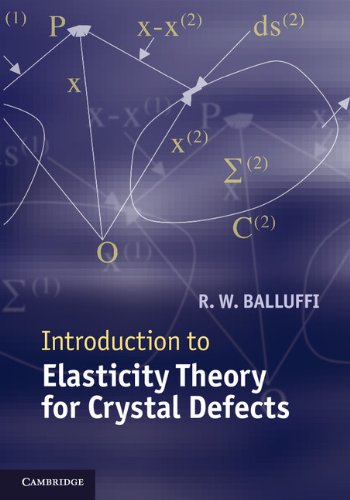Product desciption
Introduction To Elasticity Theory For Crystal Defects R W Balluffi by R W Balluffi 9781107012554, 1107012554 instant download after payment.
Self-sufficient and user-friendly, this book provides a complete introduction to the anisotropic elasticity theory necessary to model a wide range of crystal defects. Assuming little prior knowledge of the subject, the reader is first walked through the required basic mathematical techniques and methods. This is followed by treatments of point, line, planar and volume type defects such as vacancies, dislocations, grain boundaries, inhomogeneities and inclusions. Included are analyses of their elastic fields, interactions with imposed stresses and image stresses, and interactions with other defects, all employing the basic methods introduced earlier. This step by step approach, aided by numerous exercises with solutions provided, strengthens the reader's understanding of the principles involved, extending it well beyond the immediate scope of the book. As the first comprehensive review of anisotropic elasticity theory for crystal defects, this text is ideal for both graduate students and professional researchers
''Self-sufficient and user-friendly, this book provides a complete introduction to the anisotropic elasticity theory necessary to model a wide range of crystal defects. Assuming little prior knowledge of the subject, the reader is first walked through the required basic mathematical techniques and methods. This is followed by treatments of point, line, planar and volume type defects such as vacancies, dislocations, grain boundaries, inhomogeneities and inclusions. Included are analyses of their elastic fields, interactions with imposed stresses and image stresses, and interactions with other defects, all employing the basic methods introduced earlier. This step by step approach, aided by numerous exercises with solutions provided, strengthens the reader's understanding of the principles involved, extending it well beyond the immediate scope of the book. As the first comprehensive review of anisotropic elasticity theory for crystal defects, this text is ideal for both graduate students and professional researchers''-- Read more... 1. Introduction -- 2. Basic elements of linear elasticity -- 3. Methods -- 4. Green's functions for unit point force -- 5. Interactions between defects and stress -- 6. Inclusions in infinite homogeneous regions -- 7. Interactions between inclusions and imposed stress -- 8. Inclusions in finite regions-- image effects -- 9. Inhomogeneities -- 10. Point defects in infinite homogeneous regions -- 11. Point defects and stress-- image effects in finite bodies -- 12. Dislocations in infinite homogeneous regions -- 13. Dislocations and stress-- image effects in finite regions -- 14. Interfaces -- 15. Interactions between interfaces and stress -- 16. Interactions between defects -- Appendices


